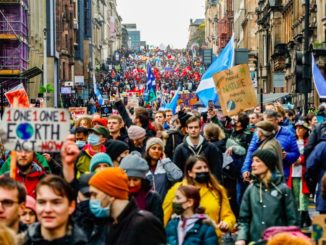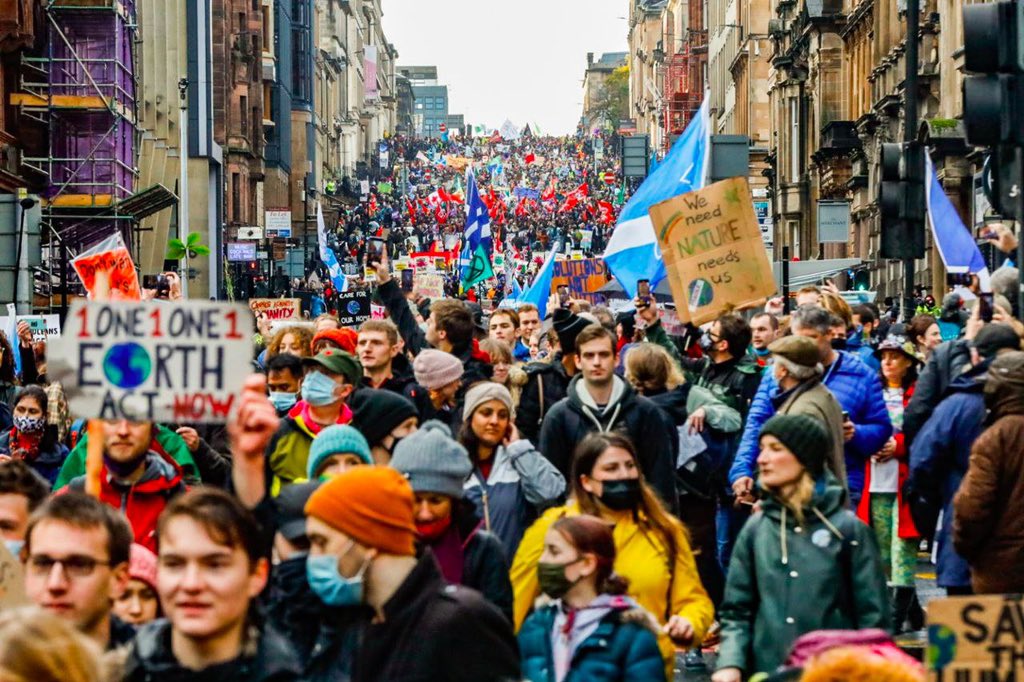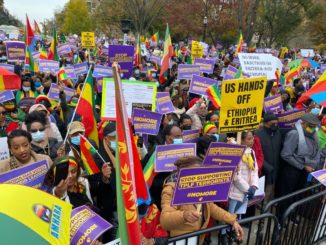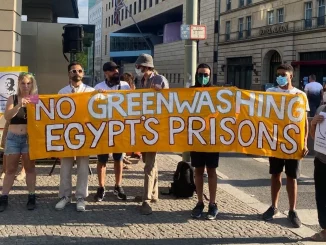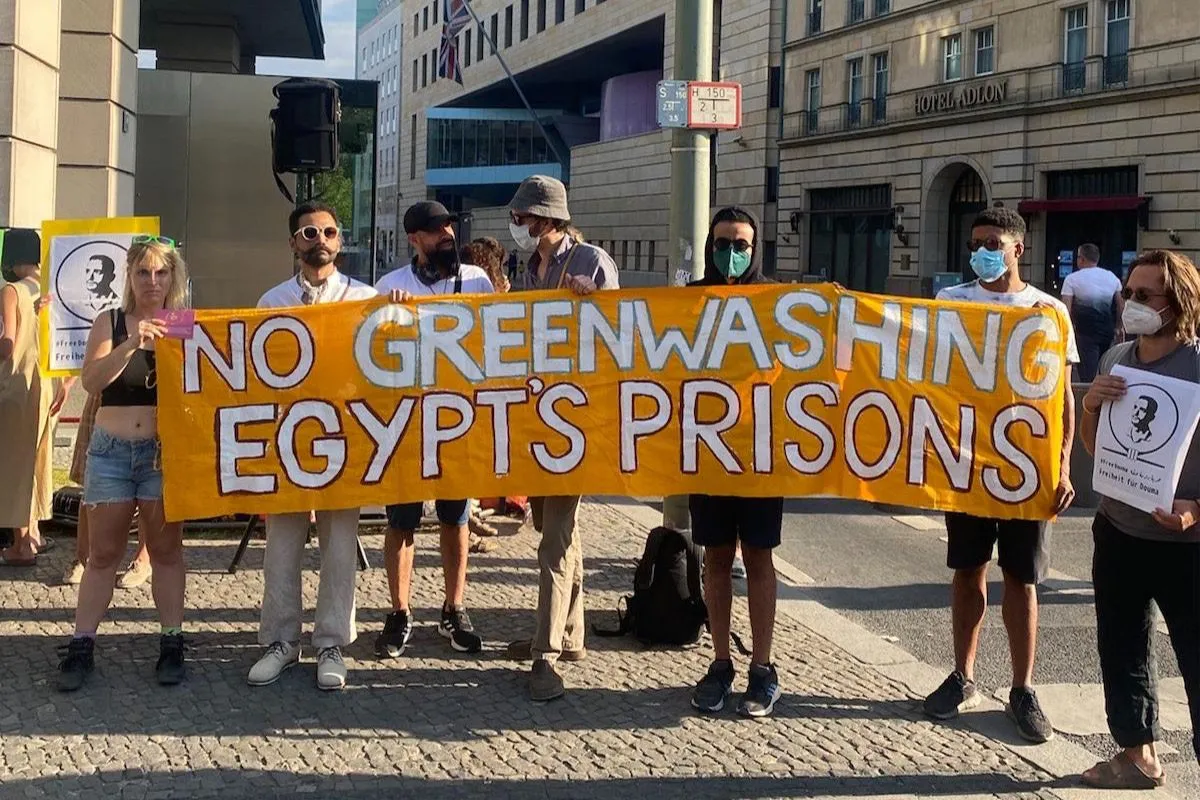
Editor’s Note: The following represents the writers’ opinion.
A free and transparent media is critical for any democracy. But in every society, defending the integrity of the media requires constant vigilance. We found ourselves drawn into the work of exercising this vigilance by complete chance.
When the independent left publication New Frame closed down after four years of operations, the liberal media rushed in, in unseemly haste, to put the boot in. Perhaps the worst of the attacks was penned by Sam Sole and Micah Reddy of the investigative journalism outfit amaBhungane. They alleged, based on nothing more than salacious gossip, that there was an attempt to influence public discourse in South Africa by the Chinese state. Not a shred of evidence was provided for this conspiracy theory by Sole and Reddy in an article that was largely based on innuendo. They abused the institutional authority of amaBhungane as a trusted publication to give credence to a conspiracy theory, one that aligned closely with the
key tropes being driven by the United States in the New Cold War.
The hostility towards us in this story can only be because our new organization, the Pan-African Institute for Socialism (PAIS), aims to create a non-sectarian space on the left to reach consensus on a pragmatic minimum program to increase the prospects for the Black poor and working-class majority in South Africa, Africa and the Global South.
PAIS has never had any sort of connection to New Frame aside from a single meeting held at their offices to inquire about the process for submitting opinion pieces for consideration, something that never actually happened in the end. But, to our complete astonishment, we found PAIS, a new and entirely unfunded organization, drawn into the conspiracy theories recycled by Sole and Reddy. This quite bizarre experience led us to wonder who funded amaBhungane, and what the drivers were for such vehemence by publications that claim to be fair, even-handed, and balanced. Those questions soon led us to an intricate web of relationships that are clearly designed to hide the influence of powerful funders and networks.
What is the real project of these U.S.-led imperialists and their surrogates in South Africa? A common thread has been the use of proxies to stymie the liberation of the majority of South Africans, particularly the Black working class and rural poor. First was Inkatha.1 Then came the DA. Lately, it is a hodge-podge of xenophobic opportunists. In addition, there are organizations that pose as being ‘Left’ and the so-called independent media. They all have one thing in common. They have an agenda to drive the ANC vote below 50 percent, in towns, cities, provinces and ultimately nationally.2
While PAIS may irritate them because we shine a spotlight on these reactionaries, their real target is the liberation movement. They wish to stymie the realization of the National Democratic Revolution, the as-yet unrealized goal of the struggle.
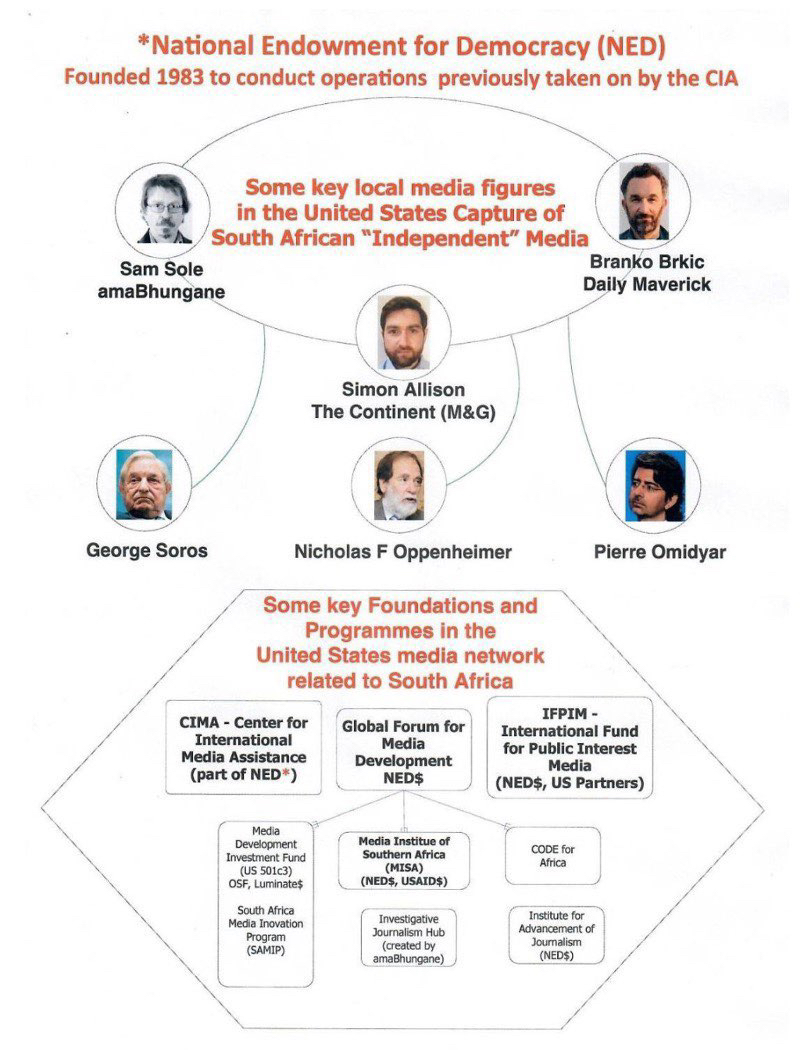
We have been stunned by the extent of the capture of much South African media by the U.S. state and how most of it is hiding in plain sight. The first article to come out of our ongoing research project, “Manufacturing consent: How the United States has penetrated South African media”3 noted a few key points, including the following:
- The National Endowment for Democracy (NED) was created in 1983 during the Reagan era to conduct operations and functions previously carried out by the CIA.4 It supported the mujahideen in Afghanistan and the Contras in Nicaragua and has been involved in many U.S.-backed coups.5 It now has vast tentacles across Africa.6
- The NED funds the Mail & Guardian’s (M&G) weekly publication The Continent7 via its own non-profit arm, Adamela Trust, and international organisations like the International Fund for Public Interest Media (IFPIM),8 and the Media Institute of Southern Africa (MISA),9 all of which are linked to key people and organisations in the South Africa media. The editor-in-chief of the Continent is Simon Allison, former Africa editor of M&G, Africa correspondent of Daily Maverick, and a former consultant with Open Society Foundation (OSF)-funded Institute for Security Studies.10 11 It is noteworthy that the NED has continued its program through Republican and Democratic administrations, from Reagan through to Biden, and was headed by Carl Gershman from its inception until 2021. Its agenda has not changed.
3. The OSF and Luminate, another major foundation, are official U.S. government partners that often work closely with the NED and other parts of the U.S. state, strategically taking on and funding projects that the U.S. state cannot or does not wish to directly undertake.12 Among the many examples of direct collaboration is that the NED and the OSF jointly founded Global Forum for Media Development (GFMD).13 The Center for International Media Assistance (CIMA) is an official initiative of NED that coordinates this work and lists OSF as a partner.14 Luminate, together with the MIDF, has facilitated “dedicated coaching and newsroom expertise in topics such as marketing, newsletters, community building, and audience development” for M&G.15
4. Key senior people in publications like the M&G and amaBhungane, including three former editors-in-chief of the M&G have gone on to work for U.S. and Western government-supported organizations, including three separate projects funded by the NED.16 17 18
5. At least fifteen people who passed through the fellowship program run by
amaBhungane have been directly tied to U.S. government organizations and programs including the Voice of America.19 amaBhungane has also led the formation of a regional investigative journalism network, IJ Hub.20
6. The M&G, the Daily Maverick and amaBhungane, as well as smaller projects like the M&G-linked Daily Vox and the local U.S. embassy-linked Africa Check,21 are part of a list of at least 24 publications that have been funded by one or more of the major funders that regularly partner with the U.S. government.22
As we continue with our research we are finding more NED links. For instance the NED has funded the Institute for Race Relations (IRR),23 which publishes the Daily Friend,24 a publication that is ostensibly liberal, but veers towards the reactionary right wing weltanschauung. Sam Sole, the editor of amaBhungane, is a member of the International Consortium of Investigative Journalists (ICIJ),25 which is funded by the NED.26 We are also finding more and more links between organizations, like the OSF and Luminate, and the U.S. state. It is also likely that some journalists are funded directly by organizations, so that the claim to independence of organizations can be upheld.
The Oppenheimer family, whose wealth was wrung from the super-exploitation of Black labor in the mines, have long had considerable influence over political life in South Africa, including during the negotiations where the right of capital to continue to exploit was affirmed.27 But it is clear that, like OSF and Luminate, the Oppenheimers are also key partners of the U.S. state. The Oppenheimers fund amaBhungane28 and are given the red carpet treatment by the Daily Maverick to platform for their surrogates such as Greg Mills to propagate their pro-Western worldview.29 Founded by Branko Brkic, the Daily Maverick does list some funders, but asks you to take a leap of faith that a group of ten trusts, companies, and individuals that own anything between 0.1 percent and 15 percent of its investment holding company, are not compromised or party to any external leverage, as a cohort or as individual opaque entities. It also raises questions that the Daily Maverick and its biggest shareholder, Inkululeko Media, are indexed by Google as sharing the same office address in St. George’s Mall, Cape Town.30 31 Their opaqueness flies in the face of the Daily Maverick’s claims of transparency, which are merely a marketing strategy. Since their reader covenant was drafted in 2009, the Daily Maverick has become an important and influential player in the polity. It has evolved beyond being a blog with an angle that punched above its lightweight class and has accrued a tremendous amount of institutional authority in shaping discourse and curating narratives. With this power comes the responsibility to precisely disclose its funding. In short, it’s time for Daily Maverick to grow up, just like its peers in the mediascape.
The Oppenheimers also fund the Institute for Race Relations (IRR),32 the South African Institute for International Affairs,33 and their own foundation, the Brenthurst Foundation34. In each case, the links to the U.S. state are clear. Chester Crocker, who was Ronald Reagan’s point man in southern Africa at the height of the Cold War35 is an “honorary life member” and board member of the IRR.36 The Brenthurst Foundation has clear and open links of various kinds to NATO. The director of the Brenthurst Foundation, Greg Mills,37 served as a special advisor to the NATO Commander David Richards, who commanded the Western coalition forces as they stomped their way across Afghanistan.38 Greg Mills39 is one of four foreign policy right-wing hawks who are “allowed” to write on geopolitical affairs by the Daily Maverick. The other three are former U.S. diplomat Brooks Spector,40 former editor of M&G and president of consultancy group Calabar Consulting, Phillip van Niekerk,41 and lifetime foreign affairs hawk and stenographer of Western imperial interests, Peter Fabricius. Fabricius and Spector are also linked to the South African Institute of International Affairs as “experts”.42 The SAIIA is funded by USAID and the U.S. Department of State.43 But the systemic capture of much of our mediascape by the U.S. state and its partners extends beyond questions of funding, training programs, revolving doors, boards and collaborations of various kinds. There is also the question of editorial lines. In a number of publications, there is a systemic bias towards pro-U.S. positions, and very, very little critique of U.S. imperialism. There are a number of people writing as independent analysts, who are in fact embedded in the U.S. state in various ways. We also see that while the media has often served the interests of the public in terms of uncovering corruption in government, it has often done comparatively little in terms of doing the same in terms of private sector corruption, abuse of workers and control of policy.
All this is just scratching the surface. We are finding much, much more evidence of widespread media capture with every hour of research. Already some key questions are emerging for future research and articles. They include the following:
- Why is the Daily Maverick’s funding not fully and precisely disclosed—including, in particular, the details on all equity, loan, or subsidy transactions?
- How are the amaBhungane fellowship and training programs funded? Are there project costs, fees and expenses received from programs funded directly or indirectly from U.S. government agencies? Why do such large numbers of the fellows go on to work for U.S. government funded projects?
- Which publishers, editors and journalists have attended the regular events for editors held by the U.S. consulate in Cape Town? What are the details of other briefings held by U.S.-directly or -indirectly funded organizations that senior leaders of South African media attend?
- Who are the former publishers, editors and journalists who now work for the U.S. state or for U.S.-state directly or -indirectly funded organizations?
- What other media projects are funded by the NED, OSF, Luminate and the Oppenheimers?
- What is the percentage of articles in our “independent” media on geopolitics that support the U.S. line on international affairs and the percentage of those that are critical?
Transparency is a basic democratic value. It is time we knew who the masters of our media really are. It cannot be acceptable that while the editors and reporters of these publications demand accountability and transparency of those in government, labor and, occasionally, in business, they arrogate to themselves the right to not meet the same standards.
Our research project is growing in scope and urgency by the day. We need help from all interested citizens of South Africa who wish to contribute to media reform in the interests of transparency and the important work of defending and deepening our democracy. As a start, we welcome suggestions for further questions for us to explore and, in due course, to present to the South African National Editors’ Forum (SANEF). Please do contact us at [email protected] and share the questions that you think should be raised.
Phillip Dexter and Roscoe Palm are co-founders of the Pan-African Institute for Socialism, which can be found on Twitter at @PaisSocialism.
Footnotes
1 The Inkatha Freedom Party (IFP) started as a cultural movement in present day KwaZulu-Natal, but quickly morphed into a political movement to oppose the ANC’s liberation struggle. See “Inkatha Freedom Party (IFP),” South African History Online.
2 For example, in a recent opinion piece in Financial Times, Gideon Rachman wrote, “The best thing [the ANC] could do for the country’s future would be to lose the next election and leave power.” Gideon Rachman, “South Africa’s fear of state failure,” Financial Times, Aug. 15, 2022
3 See Ajit Singh and Roscoe Palm, “Manufacturing consent: How the United States has penetrated South African media,” MR Online, Aug. 8, 2022.
4 See David Ignatius, “Innocence Abroad: The New World of Spyless Coups,” The Washington Post, Sept. 22, 1991 (“‘A lot of what we do today was done covertly 25 years ago by the CIA,’” agrees [Allen] Weinstein.” Weinstein was a co-founder of the NED.)
5 See David K. Shipler, “Missionaries for Democracy: U.S. Aid for Global Pluralism,” The New York Times, June 1, 1986.
6 For example, in FY2021 alone, the NED’s Africa program granted $41.5 million dollars across 34 countries and hundreds of projects. See National Endowment for Democracy, 2021 Annual Report.
7 See National Endowment for Democracy, “Regional: Africa 2021,” Feb. 11, 2022.
8 See International Fund for Public Interest Media, “About”.
9 See National Endowment for Democracy, Awarded Grants Search, (search: “Media Institute of Southern Africa”). Additionally, MISA has received funding from and is a “key partner” of the U.S. Agency for International Development. See United States. Congress. House. Committee on Appropriations. Subcommittee on Foreign Operations, Export Financing, and Related Programs, Foreign Operations, Export Financing, and Related Programs Appropriations for 2002: Hearings Before a Subcommittee of the Committee on Appropriations, House of Representatives, One Hundred Seventh Congress, First Session, U.S. Government Printing Office, 2001, p. 870.
10 See Simon Allison LinkedIn.
11 See Institute for Security Studies, “How we work”.
12 “Private sector funding of independent media abroad … has several advantages over public financing. Private funders can be more flexible … and their programs can operate in countries where U.S. government-funded programs are unwelcome. “In many places around the world, the people we train are more open to participating in programs funded by private sources than those funded by the U.S. government,” says Patrick Butler, ICFJ [International Center for Journalists] vice president.” National Endowment for Democracy, Center for International Media Assistance, Empowering Independent Media Inaugural Report: 2008, Ed. Marguerite Sullivan, (cited in Manufacturing consent article).
13 According to the Global Forum for Media Development, OSF and NED are its “core funders.” See Global Forum for Media Development, “Partnerships”.
14 See Center for International Media Assistance, “Partners”.
15 See Luminate Group, “Sixteen media selected for Membership in News Fund,” Feb. 4, 2021.
16 Roper became editor-in-chief of M&G in 2009 and left in 2015 to become the Deputy CEO of Code for Africa (CfA). CfA is a member of Code for All, which is funded by the NED. Additionally, Roper was a Knight Fellow at the International Center for Journalists, which is also funded by the NED. See, Chis Roper LinkedIn profile; Code for All, “Our Supporters”; International Center for Journalists, Impact Report, 2022, p. 17.
17 Former editor-in-chief Khadija Patel (2016-2020) left the M&G to chair the NED-sponsored International Press Institute. In 2021, Patel became head of programs at the NED-funded International Fund for Public Interest Media (IFPIM). See fn. 2 (above) (NED funding of IFPIM); International Press Institute, “Supporters and Partners”; International Press Institute, “Executive Board”; International Fund for Public Interest Media, “About”.
18 Former editor-in-chief Phillip van Niekerk (1997-2000) left the M&G to take up a senior position at the International Consortium of Investigative Journalists (ICIJ) in Washington D.C. ICIJ is funded by the NED. See “New editor of M&G,” Mail & Guardian, Mar. 20, 1997; “Over to you, Dr Barrell,” Mail & Guardian, Dec. 15, 2000; International Consortium of Investigative Journalists, “Our Supporters”.
19 See “Manufacturing consent: How the United States has penetrated South African media.” Full citation at fn. 3.
20 AmaBhungane “is incubating the Hub… As incubator, amaBhungane has continued to support the Hub administratively.” IJ Hub, Annual Narrative Report 2021/21.
21 See Africa Check, “Partners” (“The U.S. Embassy in South Africa is proud to team up with Africa Check to tackle misinformation and disinformation in the media.”).
22 In addition to their own media-related grants, OSF and Luminate jointly founded the South African Media Innovation Program, a multi-million dollar media investment initiative managed by the Media Development Investment Fund, which is also funded by OSF and Luminate. See South Africa Media Innovation Program; Luminate Group, “South Africa Media Innovation Program (SAMIP) launched by Open Society Foundation of South Africa (OSF-SA), Omidyar Network, and Media Development Investment Fund,” Aug. 29, 2017.
23 See i.e. South African Institute of Race Relations, 86th Annual Report, 2015, p. 7. Additionally, the IRR has partnered with the International Republican Institute, which is one of NED’s four core institutes. See International Republican Institute, “Democratic Governance in Africa”; National Endowment for Democracy, “How We Work”. The IRR is also a member institute of the NED’s Network of Democracy Research Institutes. (See National Endowment for Democracy, “NDRI Member Institutes” (https://www.ned.org/ideas/network-of-democracy-research-institutes-ndri/ndri-member-institutes/#Top).
24 “The Daily Friend is the online newspaper of the Institute of Race Relations.” Daily Friend, “About” (https://dailyfriend.co.za/about/).
25 See International Consortium of Investigative Journalists, “Sam Sole”.
26 See International Consortium of Investigative Journalists, “Our Supporters”.
27 See Sampie Terreblanche, “The New South Africa’s original ‘State Capture’”, Africa Is a Country, Jan. 28, 2018.
28 See amaBhungane, “About Us”.
29 See https://www.dailymaverick.co.za/author/ray-hartley-and-greg-mills
30 See https://www.sayellow.com/view/south-africa/daily-maverick-in-cape-town
31 See footer on Inkululeko website for address.
32 See Oppenheimer Memorial Trust, “All Beneficiaries – S”
33 See Oppenheimer Memorial Trust, “All Beneficiaries – S”
34 See The Brenthurst Foundation, “Our Story”.
35 Interestingly, a 1983 New York Times profile of the Oppenheimer empire opens with the following: “In an oracular vein, an academic named Chester A. Crocker once said of South Africa: That country is by its nature a part of the West. It is an integral and important element of the Western global, economic system. Mr. Crocker, who has since become the State Department’s top Africa hand and author of the Reagan Administration’s policy of “constructive engagement” with South Africa’s white minority Government, was openly embracing a premise found in both South African propaganda and the arguments of Marxist analysts: that the West’s formal condemnations of apartheid mask an enormous stake in the outcome of the shadowy struggle between the races there.” See Joseph Lelyveld, “Oppenheimer of South Africa,” The New York Times, May 8, 1983.
36 See South African Institute of Race Relations, 92nd Annual Report, 2021, p. 6.
37 See The Brenthurst Foundation, “Greg Mills”.
38 See Greg Mills, From Africa to Afghanistan: With Richards and NATO to Kabul, Wits University Press, 2007.
40 See J. Brooks Spector author page at Daily Maverick.
41 See Phillip van Niekerk author page at Daily Maverick.
42 See South African Institute of International Affairs “Expert” pages for Peter Fabricius and Brooks Spector.
43 See South African Institute of International Affairs, “Funders”.

